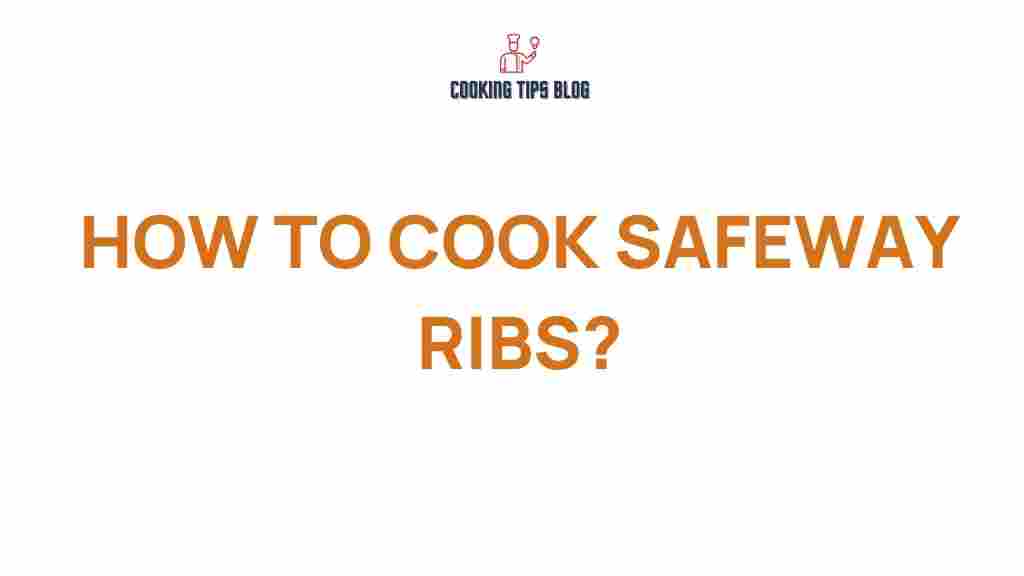Mastering the Art of Cooking Safeway Ribs
When it comes to barbecue, few things can rival the succulent taste of ribs. Among the many options available, Safeway ribs have gained a reputation for their quality and flavor. Whether you’re hosting a backyard barbecue or looking for a weeknight dinner option, mastering the art of cooking Safeway ribs can elevate your culinary game. In this article, we’ll explore tips and techniques to help you achieve mouthwatering results every time.
Understanding Safeway Ribs
Before diving into the cooking techniques, it’s essential to understand the types of ribs you can find at Safeway. Typically, you’ll encounter the following varieties:
- Pork Spare Ribs: These ribs are meatier and have a higher fat content, making them incredibly flavorful.
- Pork Baby Back Ribs: These are smaller and leaner than spare ribs, providing a tender bite but with less fat.
- Beef Ribs: Known for their robust flavor, beef ribs are larger and can be a fantastic choice if you prefer a heartier meal.
Choosing the right type of rib is crucial for achieving the best results. Now that you know what to look for, let’s move on to the cooking techniques.
Tips for Cooking Safeway Ribs
Cooking Safeway ribs requires a blend of preparation, seasoning, and cooking techniques. Here are some essential tips to ensure your ribs turn out delicious every time:
1. Preparation is Key
Before you even think about cooking, you need to prepare your ribs properly:
- Remove the Membrane: On the bone side of the ribs, there is a thin membrane that can make the ribs tough. Use a knife to gently pry it off for a more tender result.
- Trim Excess Fat: While some fat adds flavor, too much can lead to greasy ribs. Trim any excess fat to your liking.
- Rinse and Pat Dry: Rinse your ribs under cold water and pat them dry with paper towels. This helps remove any residual blood and makes for a cleaner cooking surface.
2. Seasoning Your Ribs
Seasoning is crucial in enhancing the flavor of your Safeway ribs. Here’s how to do it right:
- Dry Rub: Create a dry rub using a combination of salt, pepper, paprika, garlic powder, and brown sugar. Apply the rub generously on both sides of the ribs.
- Marinating: For deeper flavor, consider marinating your ribs overnight. A simple marinade can include soy sauce, honey, and apple cider vinegar.
3. Cooking Techniques
There are several methods you can use to cook Safeway ribs, including grilling, baking, and smoking. Here’s a breakdown of each method:
Grilling
Grilling ribs can yield a fantastic smoky flavor:
- Preheat your grill to a medium heat.
- Place the ribs bone-side down over indirect heat.
- Close the lid and cook for about 2 to 3 hours, basting with barbecue sauce during the last 30 minutes for a caramelized finish.
Baking
Baking is a foolproof method that can produce tender ribs:
- Preheat your oven to 275°F (135°C).
- Wrap the seasoned ribs in aluminum foil, making sure they’re tightly sealed.
- Bake for 2.5 to 3 hours. Unwrap the foil, brush with barbecue sauce, and bake for an additional 30 minutes for a sticky glaze.
Smoking
If you have a smoker, this method is ideal for infusing rich flavors:
- Preheat your smoker to 225°F (107°C).
- Place the ribs on the smoker grates and cook for about 4 to 6 hours, depending on the thickness.
- Apply barbecue sauce during the last hour of cooking for a sweet finish.
4. Resting and Serving
Once your ribs are cooked, don’t forget the resting period. Allow them to rest for at least 10 to 15 minutes before slicing. This helps the juices redistribute, keeping the meat tender and juicy.
When serving, cut the ribs between the bones and present them on a platter. Drizzle extra barbecue sauce on top for an added touch of flavor.
Troubleshooting Common Issues with Safeway Ribs
Even the best cooks can run into problems. Here are some common issues you may encounter when cooking Safeway ribs, along with solutions:
1. Ribs are Tough
If your ribs turn out tough, it’s likely due to undercooking or not removing the membrane. Always ensure the ribs are cooked low and slow for the best tenderness.
2. Ribs Lack Flavor
If your ribs lack flavor, consider these options:
- Use a more robust dry rub or marinade.
- Let the ribs marinate longer or apply the dry rub several hours before cooking.
3. Ribs are Dry
Dry ribs can occur from overcooking. Always keep an eye on the cooking time and use a meat thermometer to check for doneness. Ribs should reach an internal temperature of 190°F (88°C) for optimal tenderness.
Conclusion
Mastering the art of cooking Safeway ribs can enhance your culinary repertoire and impress your guests. With the right preparation, seasoning, and cooking techniques, you can create tender, flavorful ribs that are sure to be a hit at any gathering. Remember, practice makes perfect, so don’t be discouraged by initial setbacks. For more tips and recipes, check out our cooking blog for inspiration!
Now that you have the knowledge, it’s time to fire up your grill or oven and get cooking. Enjoy the process and savor every bite of your delicious Safeway ribs!
This article is in the category Recipes and created by Cookingtipsblog Team
